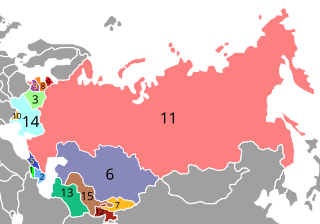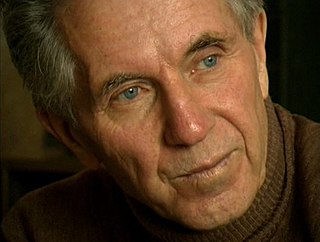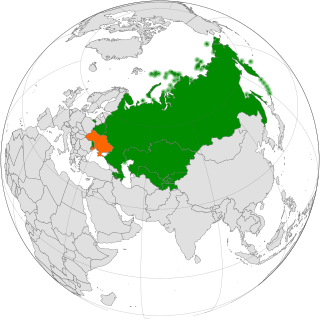
The member states of the United Nations comprise 193 sovereign states. The United Nations (UN) is the world's largest intergovernmental organization. All members have equal representation in the UN General Assembly.

The Commonwealth of Independent States (CIS) is a regional intergovernmental organization in Eurasia. It was formed following the dissolution of the Soviet Union in 1991. It covers an area of 20,368,759 km2 (7,864,422 sq mi) and has an estimated population of 239,796,010. The CIS encourages cooperation in economic, political and military affairs and has certain powers relating to the coordination of trade, finance, lawmaking, and security, including cross-border crime prevention.

Belarusian is an East Slavic language. It is one of the two official languages in Belarus, alongside Russian. Additionally, it is spoken in some parts of Russia, Lithuania, Latvia, Poland, and Ukraine by Belarusian minorities in those countries.

The politics of Belarus takes place in a framework of a presidential republic with a bicameral parliament. The President of Belarus is the head of state. Executive power is nominally exercised by the government, at its top sits a ceremonial prime minister, appointed directly by the President. Legislative power is de jure vested in the bicameral parliament, the National Assembly, however the president may enact decrees that are executed the same way as laws, for undisputed time.
Succession of states is a concept in international relations regarding a successor state that has become a sovereign state over a territory that was previously under the sovereignty of another state. The theory has its roots in 19th-century diplomacy. A successor state often acquires a new international legal personality, which is distinct from a continuing state, also known as a continuator or historical heir, which despite change to its borders retains the same legal personality and possess all its existing rights and obligations.

The Russian Academy of Sciences consists of the national academy of Russia; a network of scientific research institutes from across the Russian Federation; and additional scientific and social units such as libraries, publishing units, and hospitals.
A national academy is an organizational body, usually operating with state financial support and approval, that co-ordinates scholarly research activities and standards for academic disciplines, and serve as public policy advisors, research institutes, think tanks, and public administration consultants for governments or on issues of public importance, most frequently in the sciences but also in the humanities. Typically the country's learned societies in individual disciplines will liaise with or be coordinated by the national academy. National academies play an important organisational role in academic exchanges and collaborations between countries.
An academician is a full member of an artistic, literary, engineering, or scientific academy. In many countries, it is an honorific title used to denote a full member of an academy that has a strong influence on national scientific life. In systems such as the Academy of Sciences of the USSR, the title grants privileges and administrative responsibilities for funding allocation and research priorities.

The Patrice Lumumba Peoples’ Friendship University of Russia, also known as RUDN University and until 1992 and after March 2023, as Patrice Lumumba University in honour of the Congolese politician Patrice Lumumba, is a public research university located in Moscow, Russia. It was established in 1960 by a resolution from the Central Committee of the CPSU and the Council of Ministers of the USSR to help nations to assist countries that had recently achieved independence from colonial powers. The University also acted to further Soviet foreign policy goals in nonaligned countries.

The post-Soviet states, also referred to as the former Soviet Union (FSU) or the former Soviet republics, are the independent sovereign states that emerged/re-emerged out of the dissolution of the Soviet Union in 1991. Prior to their independence, they existed as Union Republics — top-level constituents of the Soviet Union. There are 15 post-Soviet states in total: Armenia, Azerbaijan, Belarus, Estonia, Georgia, Kazakhstan, Kyrgyzstan, Latvia, Lithuania, Moldova, Russia, Tajikistan, Turkmenistan, Ukraine, and Uzbekistan. Each of these countries succeeded their respective Union Republics: the Armenian SSR, the Azerbaijan SSR, the Byelorussian SSR, the Estonian SSR, the Georgian SSR, the Kazakh SSR, the Kirghiz SSR, the Latvian SSR, the Lithuanian SSR, the Moldavian SSR, the Russian SFSR, the Tajik SSR, the Turkmen SSR, the Ukrainian SSR, and the Uzbek SSR. In Russia, the term "near abroad" is sometimes used to refer to other post-Soviet states.

The Russian Federation succeeded to the Soviet Union's seat, including its permanent membership on the Security Council in the United Nations after the 1991 dissolution of the Soviet Union, which originally co-founded the UN in 1945. The succession was supported by the USSR's former members and was not objected to by the UN membership; Russia accounted for more than 75% of the Soviet Union's economy, the majority of its population and 75% of its land mass; in addition, the history of the Soviet Union began in Russia with the October Revolution in 1917 in Petrograd. If there was to be a successor to the Soviet seat on the Security Council among the former Soviet republics, these factors made Russia seem a logical choice. Nonetheless, due to the rather inflexible wording of the UN Charter and its lack of provision for succession, the succession's technical legality has been questioned by some international lawyers.

The National Academy of Sciences of Ukraine is a self-governing state-funded organization in Ukraine that is the main center of development of science and technology by coordinating a system of research institutes in the country. It is the main research oriented organization along with the five other academies in Ukraine specialized in various scientific disciplines. NAS Ukraine consists of numerous departments, sections, research institutes, scientific centers and various other supporting scientific organizations.

The Belovezha Accords is the agreement declaring that the Union of Soviet Socialist Republics (USSR) had effectively ceased to exist and establishing the Commonwealth of Independent States (CIS) in its place as a successor entity. The documentation was signed at the state dacha near Viskuli in Belovezhskaya Pushcha, Belarus on 8 December 1991, by leaders of three of the four republics which had signed the 1922 Treaty on the Creation of the USSR:

The Eurasian Scout Region is the divisional office of the World Scout Bureau of the World Organization of the Scout Movement, headquartered in Kyiv, formerly located at Gurzuf near Yalta-Krasnokamianka, Ukraine, with a branch office in Moscow. All the formerly communist states of Central and Eastern Europe, Central Asia and the Soviet Union have developed or are developing Scouting in the wake of the renaissance in the region. These include most of the successor states to the Soviet Union, in the Commonwealth of Independent States. The 1996/99 Triennial Report of the World Scout Committee/World Organization of the Scout Movement shows that WOSM is aggressively pursuing the organization of Scouting activities in the countries of the former Soviet Union, according to its own vision.

The National Academy of Sciences of Belarus is the national academy of Belarus.

The Academy of Sciences of the Soviet Union was the highest scientific institution of the Soviet Union from 1925 to 1991. It united the country's leading scientists and was subordinated directly to the Council of Ministers of the Soviet Union.

Vassili Nesterenko was a Soviet and Belarusian physicist from Ukraine and a former director of the Institute of Nuclear Energy at the National Academy of Sciences of Belarus (1977–1987).

On the basis of a secret clause of the Molotov–Ribbentrop Pact, the Soviet Union invaded Poland on September 17, 1939, capturing the eastern provinces of the Second Polish Republic. Lwów, the capital of the Lwów Voivodeship and the principal city and cultural center of the region of Galicia, was captured and occupied by September 22, 1939 along with other provincial capitals including Tarnopol, Brześć, Stanisławów, Łuck, and Wilno to the north. The eastern provinces of interwar Poland were inhabited by an ethnically mixed population, with ethnic Poles as well as Polish Jews dominant in the cities. These lands now form the backbone of modern Western Ukraine and West Belarus.

Lesbian, gay, bisexual, and transgender (LGBT) persons in the former Soviet Union face legal challenges not experienced by non-LGBT residents. Since 1 January 2016, in Estonia followed by Latvia, same-sex couples have recognition called a cohabitation agreement that gives the same legal protections available to opposite-sex couples. On 11 January 2019, the Supreme Court of Lithuania ruled that same-sex spouses must be granted residence permits, while a cohabitation agreement is pending.

Relations between Ukraine and the Commonwealth of Independent States (CIS) are multilateral international relations between a third state and a supranational organization.
















